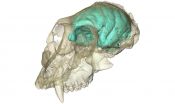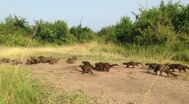(Press-News.org) It may sound counter-intuitive, but crushing up bees into a 'DNA soup' could help conservationists understand and even reverse their decline - according to University of East Anglia scientists.
Research published today in the journal Methods in Ecology and Evolution shows that collecting wild bees, extracting their DNA, and directly reading the DNA of the resultant 'soup' could finally make large-scale bee monitoring programmes feasible.
This would allow conservationists to detect where and when bee species are being lost, and importantly, whether conservation interventions are working.
The UK's National Pollinator Strategy plans a large-scale bee monitoring programme. Traditional monitoring involves pinning individual bees and identifying them under a microscope. But the number of bees needed to track populations reliably over the whole country makes traditional methods infeasible.
This new research shows how the process could become quicker, cheaper and more accurate.
Researchers from UEA worked in partnership with Conservation Grade and the University of Reading in the UK, and the Kunming Institute of Zoology and the China National GeneBank at BGI-Shenzhen in China.
Lead researcher Prof. Douglas Yu, from UEA's School of Biology, said: "Wild bees play a key role in pollinating wild plants and cultivated crops - maintaining both biodiversity and food production. They are however threatened by habitat loss, pesticides, climate change and disease. Safeguarding wild bee populations and their pollination services is therefore a top priority.
"Developing an efficient long-term monitoring programme to better understand the causes of their decline is one of the goals of DEFRA's National Pollinator Strategy. This will involve a massive collection of bees across the UK. Traditionally they would be pinned and identified under a microscope, but this is so labour-intensive and error-prone that the resulting data might not be available for years after the collections.
"We need more efficient identification methods if we are to improve our understanding of bee populations and their responses to conservation interventions. The big challenge is that there are hundreds of wild bee species per country, almost 300 in the UK alone. Even with the necessary expertise, it would be impossibly time-consuming to count and identify all the bees in each location - which is where the 'soup' comes in."
The research team took samples of bees from different locations in the Chilterns, the Hampshire Downs and Low Weald. A total of 204 bees were extracted, and the resulting soups put through a DNA sequencer.
The scientists then used a computer program to map the raw DNA reads against the genomes of bee mitochondria, which are found in nearly every animal cell. Each bee species has a distinct genome, allowing the team to identify which species of bees had been present in each sample.
The process did not require taxonomic experts and still proved to be more accurate. Also, by skipping the DNA-amplification step known as PCR, the method was able to estimate the biomass contributed by each species, which opens the way to tracking population trajectories.
Prof. Yu said: "The number of bees that end up in one of my soups is absolutely tiny compared with the populations being studied.
"At present, bees are collected and monitored using traditional methods, which are slow, expensive, and there is a lot more room for error.
"A computer programme doesn't have an opinion. It is or it isn't a Bombus lucorum bumblebee, and all the evidence supporting an identification is publicly available.
"Insect soup is a sensitive thermometer for the state of nature. And large-scale bee monitoring programmes would really benefit from this type of DNA sequencing. The method can easily be scaled up to track more species, like the 1000 or so total pollinating insects in the UK.
"We can find out where species diversity or abundance is highest - for example in the countryside or in city parks- and how species diversity is affected by farming methods - for example, to see if habitat set-asides support more bees.
"Species biodiversity at any given site can be revealed in a single drop of soup. It's a technique that shaves weeks, months, years off traditional ecological methods, saves money and spares the need for tons of taxonomic expertise.
"We're trying to speed up ecological investigation on a monumental scale."
INFORMATION:
'High-throughput monitoring of wild bee diversity and abundance via mitogenomics' is published in the journal Methods in Ecology and Evolution on July 6, 2015. The research was funded via studentships from the Natural Environment Research Council (NERC), the Biotechnology and Biological Sciences Research Council (BBSRC), and with support from Conservation Grade.
BARCELONA-LUGANO, 4 July 2015 - Patients with metastatic colorectal cancer (mCRC) that are mutation-free in the KRAS, NRAS, BRAF and PIK3CA genes showed significant benefit from continuing anti-epidermal growth factor receptor (EGFR) therapy beyond progression following first-line chemotherapy and an anti-EGFR monoclonal antibody, according to study results (1) presented today at the ESMO 17th World Congress on Gastrointestinal Cancer in Barcelona, Spain.
Prof Fortunato Ciardiello from Seconda Università degli Studi di Napoli, Italy, presented results from the CAPRI-Goim ...
Mice that are exposed to the powerful smell of cat urine early in life do not escape from cats later in life. Researchers at the A. N. Severtsov Institute of Ecology and Evolution, Russia, have discovered that mice that smell cat urine early in life, do not avoid the same odour, and therefore do not escape from their feline predators, later in life.
"Because the young mice (less than 2 weeks-old) are being fed milk while being exposed to the odour, they experience positive reinforcement," says Dr Vera Voznessenskaya, one of the lead researchers behind this study. "So ...
To mark the final day of the 65th Lindau Nobel Laureate Meeting, on Friday, 3 July, over 30 Nobel laureates assembled on Mainau Island on Lake Constance signed a declaration on climate change. The "Mainau Declaration 2015 on Climate Change" states "that the nations of the world must take the opportunity at the United Nations Climate Change Conference in Paris in December 2015 to take decisive action to limit future global emissions." It is expected that a new international agreement on climate protection will be approved at the 21st UN Climate Conference to succeed the ...
DURHAM, N.C. -- The brain hidden inside the oldest known Old World monkey skull has been visualized for the first time. The creature's tiny but remarkably wrinkled brain supports the idea that brain complexity can evolve before brain size in the primate family tree.
The ancient monkey, known scientifically as Victoriapithecus, first made headlines in 1997 when its fossilized skull was discovered on an island in Kenya's Lake Victoria, where it lived 15 million years ago.
Now, thanks to high-resolution X-ray imaging, researchers have peered inside its cranial cavity ...
BARCELONA-LUGANO, 3 July 2015 - The phase IIIb CONSIGN study has confirmed the benefit of regorafenib in patients with previously treated metastatic colorectal cancer (mCRC), researchers announced at the ESMO 17th World Congress on Gastrointestinal Cancer 2015 in Barcelona.(1) The safety profile and progression free survival were similar to phase III trial results.
CONSIGN was a prospective, observational study that was initiated to allow patients with mCRC access to regorafenib before marketing authorisation and to assess safety, which was the primary endpoint. The randomised ...
Spiders travel across water like ships, using their legs as sails and their silk as an anchor, according to research published in the open access journal BMC Evolutionary Biology. The study helps explain how spiders are able to migrate across vast distances and why they are quick to colonise new areas.
Common spiders are frequently observed to fly using a technique called 'ballooning'. This involves using their silk to catch the wind which then lifts them up into the air. Ballooning spiders are estimated to move up to 30 km per day when wind conditions are suitable, helping ...
Scientists have developed a new technique allowing the bioprinting at ambient temperatures of a strong paste similar to 'play dough' capable of incorporating protein-releasing microspheres.
The scientists demonstrated that the bioprinted material, in the form of a micro-particle paste capable of being injected via a syringe, could sustain stresses and strains similar to cancellous bone - the 'spongy' bone tissue typically found at the end of long bones.
This work, published today (3 July 2015) in the journal Biofabrication, suggests that bioprinting at ambient temperatures ...
A therapy that replaces the faulty gene responsible for cystic fibrosis in patients' lungs has produced encouraging results in a major UK trial.
One hundred and thirty six patients aged 12 and over received monthly doses of either the therapy or the placebo for one year.
The clinical trial reached its primary endpoint with patients who received therapy having a significant, if modest benefit in lung function compared with those receiving a placebo.
Patients from across England and Scotland participated, and were treated in two centres, Royal Brompton Hospital in ...
Banded mongooses take extraordinary risks to ensure that they find the right mate.
Female banded mongooses risk their lives to mate with rivals during pack 'warfare' and both males and females have also learned to discriminate between relatives and non-relatives to avoid inbreeding even when mating within their own social group.
Researchers from the University of Exeter and Liverpool John Moores University found that 18% of wild banded mongoose pups are fathered by males from rival packs.
Banded mongooses are found living in stable social groups across Central ...
For the first time gene therapy for cystic fibrosis has shown a significant benefit in lung function compared with placebo, in a phase 2 randomised trial published in The Lancet Respiratory Medicine journal. The technique replaces the defective gene response for cystic fibrosis by using inhaled molecules of DNA to deliver a normal working copy of the gene to lung cells.
"Patients who received the gene therapy showed a significant, if modest, benefit in tests of lung function compared with the placebo group and there were no safety concerns," said senior author Professor ...




